-
Countries
-
Data and Analysis
-
Special Focus
-
Crisis Responses

Contact
DTM DRC, iomdrcdtm@iom.int
Language
English
Location
Democratic Republic of the Congo
Period Covered
Mar 10 2024
Apr 07 2024
Activity
- Registration
- Rapid Emergency Registration
- Verification for Registration
The conflict between the Armed Forces of the Democratic Republic of Congo (FARDC) and the M23 group has intensified since March 2022, leading to a serious humanitarian crisis in the region. The ongoing violence has forced large numbers of people to leave their homes, seeking refuge in host communities and makeshift sites in regions such as Goma, Nyiragongo, Rutshuru and Masisi. With over 100 sites set up to accommodate these displaced populations, the situation points to an urgent need for humanitarian assistance and intervention. In response to this crisis, the International Organization for Migration (IOM) has launched its Camp Coordination and Camp Management (CCCM) program to improve coordination between the various actors and services operating in these sites, as well as its Displacement Tracking Matrix (DTM) to effectively manage the crucial information needed to deliver assistance and advocate support for those affected by the conflict.
From 21 March to 7 April, DTM carried out verification activities in parallel with registration to update data in response to the influx of populations into the sites, that followed an upsurge in violence observed in January 2024. Working closely with state partners such as the Commission Nationale pour les Réfugiés (CNR) and the Division Provinciale des Actions Humanitaires et de la Solidarité Nationale du Nord-Kivu (DIVAH-SN), DTM focused on assessing 88 sites identified under IOM's CCCM program as a group of sites located along the Kanyaruchinya axis.
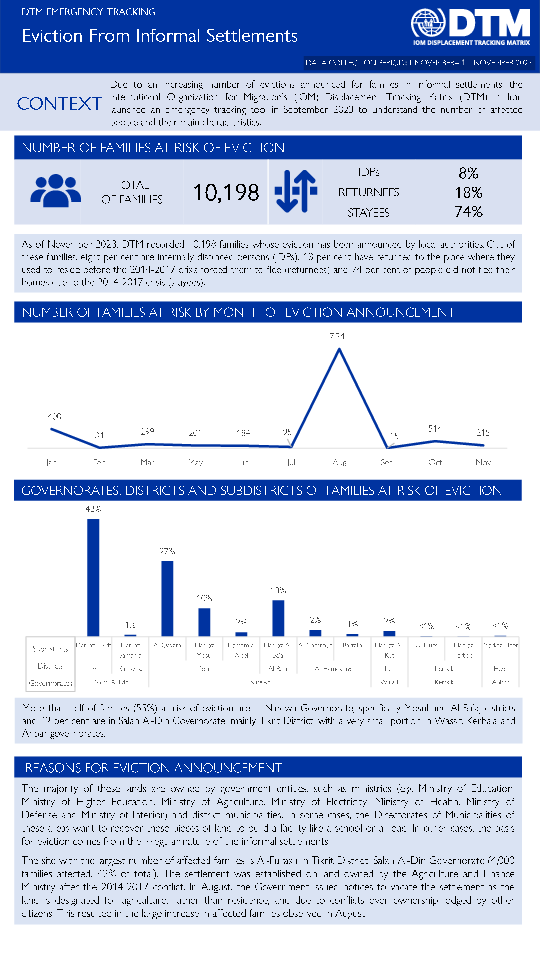
Contact
IraqDTM@iom.int
Language
English
Location
Iraq
Period Covered
Nov 01 2023
Nov 14 2023
Activity
- Mobility Tracking
- Event Tracking
Due to an increasing number of evictions announced for families in informal settlements, the International Organization for Migration’s (IOM) Displacement Tracking Matrix (DTM) in Iraq launched an emergency tracking tool in September 2023 to understand the number of affected people and their main characteristics.
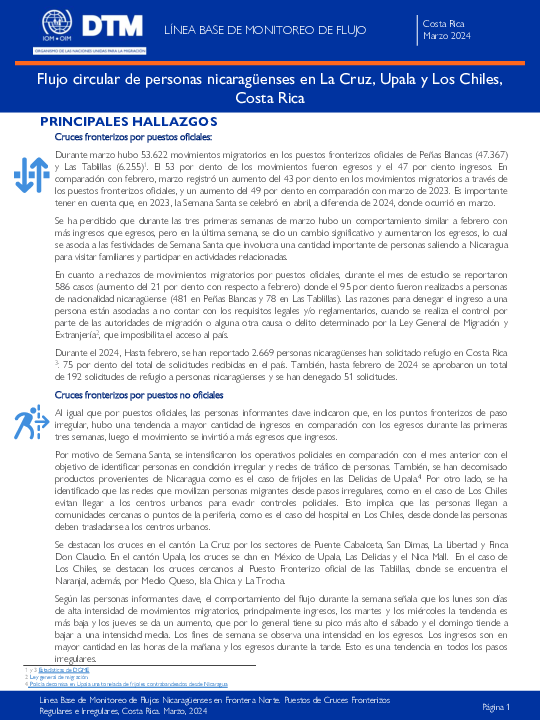
Contact
DTMCostaRica@iom.int
Language
Spanish
Location
Costa Rica
Period Covered
Mar 01 2024
Mar 31 2024
Activity
- Flow Monitoring
- Baseline Assessment
La Organización Internacional para las Migraciones (OIM), como agencia de las Naciones Unidas en materia de migración en Costa Rica, implementó, desde 2021, dos rondas de la Matriz de Seguimiento al Desplazamiento (DTM por sus siglas en inglés) como parte de su estrategia de monitoreo del flujo migratorio circular de personas de nacionalidad nicaragüense, en puntos fronterizos no oficiales, en distintos cantones del norte del país. A partir de este ejercicio en tres puntos de ingreso no oficial de la frontera con Nicaragua, se contabilizaron 60 697 movimientos migratorios, de los cuales el 59 por ciento fueron egresos y 41 por ciento ingresos.
Siendo parte fundamental de la misión de OIM brindar asesoría clave sobre políticas y prácticas migratorias, se vuelve necesario actualizar los datos de este flujo migratorio circular de nicaragüenses que cruzan tanto de forma regular como irregular la frontera norte de Costa Rica.
Según los registros de la DGME de ingresos y egresos regulares por puestos fronterizos oficiales en Los Chiles y Peñas Blancas, en 2022 hubo 394.730 movimientos migratorios regulares (50 % ingresos y 50 % egresos) mientras que durante el 2023, en total se registraron 526.271 movimientos migratorios (50 % ingresos y 50 % egresos), lo cual representó un aumento de 33 por ciento con respecto a 2022. Durante marzo de 2024, se realizaron un total de 53.622 movimientos migratorios siendo el 53 por ciento egresos y el 47 por ciento egresos.
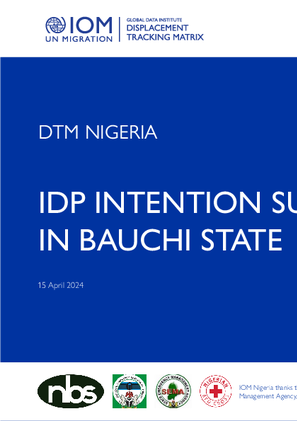
Contact
DTM Nigeria, iomnigeriadtm@iom.int
Language
English
Location
Nigeria
Period Covered
Nov 16 2023
Dec 18 2023
Activity
- Survey
- Displacement Solutions
- Return Intention
While many of the IDPs continued to be displaced for prolonged periods, there is a noticeable trend of increasing numbers of IDPs returning to their places of origin, as evidenced by Round 45 of DTM assessments (June 2023) identified 2,075,257 returnees in the region. Recognizing the growing number of returnees, the IOM Displacement Tracking Matrix (DTM), in collaboration with the Camp Coordination and Camp Management (CCCM)/Shelter and NFI and Protection sectors, including the National Emergency Management Agency (NEMA), National Bureau of Statistics (NBS), State Emergency Management Agency (SEMA), Nigeria Red Cross Society (NRCS), and other key partners deemed it necessary to assess the future intentions (within the next 12 months) of individuals in displacement areas to provide appropriate solution interventions. The DTM team, with the support of the partners, led the Intention Survey (IS) in Bauchi State (including the other five states of the north-east) to assess IDPs who wish to return to their place of origin, locally integrate at their current location of displacement or relocate to another part of the state (LGA), within or outside the country.
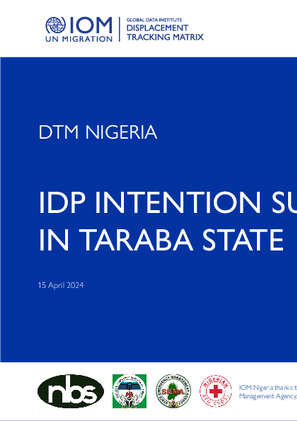
Contact
DTM Nigeria, iomnigeriadtm@iom.int
Language
English
Location
Nigeria
Period Covered
Nov 16 2023
Dec 18 2023
Activity
- Survey
- Displacement Solutions
- Return Intention
While many of the IDPs continued to be displaced for prolonged periods, there is a noticeable trend of increasing numbers of IDPs returning to their places of origin, as evidenced by Round 45 of DTM assessments (June 2023) identified 2,075,257 returnees in the region. Recognizing the growing number of returnees, the IOM Displacement Tracking Matrix (DTM), in collaboration with the Camp Coordination and Camp Management (CCCM)/Shelter and NFI and Protection sectors, including the National Emergency Management Agency (NEMA), National Bureau of Statistics (NBS), State Emergency Management Agency (SEMA), Nigeria Red Cross Society (NRCS), and other key partners deemed it necessary to assess the future intentions (within the next 12 months) of individuals in displacement areas to provide appropriate solution interventions. The DTM of the IOM Nigeria Mission, with the support of the partners, led the Intention Survey (IS) in Taraba State (including the other five states of the north-east) to assess IDPs who wish to return to their place of origin, locally integrate at their current location of displacement or relocate to another part of the state (LGA), within or outside the country.

Contact
DTM Nigeria, iomnigeriadtm@iom.int
Language
English
Location
Nigeria
Period Covered
Nov 16 2023
Dec 18 2023
Activity
- Survey
- Displacement Solutions
- Return Intention
While many of the IDPs continued to be displaced for prolonged periods, there is a noticeable trend of increasing numbers of IDPs returning to their places of origin, as evidenced by Round 45 of DTM assessments (June 2023) identified 2,075,257 returnees in the region. Recognizing the growing number of returnees, the IOM Displacement Tracking Matrix (DTM), in collaboration with the Camp Coordination and Camp Management (CCCM)/Shelter and NFI and Protection sectors, including the National Emergency Management Agency (NEMA), National Bureau of Statistics (NBS), State Emergency Management Agency (SEMA), Nigeria Red Cross Society (NRCS), and other key partners deemed it necessary to assess the future intentions (within the next 12 months) of individuals in displacement areas to provide appropriate solution interventions. The DTM of the IOM Nigeria Mission, with the support of the partners, led the Intention Survey (IS) in Gombe State (including the other five states of the north-east) to assess IDPs who wish to return to their place of origin, locally integrate at their current location of displacement or relocate to another part of the state (LGA), within or outside the country.
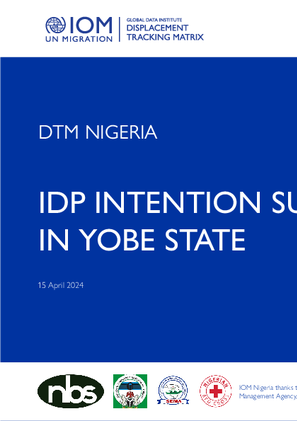
Contact
DTM Nigeria, iomnigeriadtm@iom.int
Language
English
Location
Nigeria
Period Covered
Nov 16 2023
Dec 18 2023
Activity
- Survey
- Displacement Solutions
- Return Intention
While many of the IDPs continued to be displaced for prolonged periods, there is a noticeable trend of increasing numbers of IDPs returning to their places of origin, as evidenced by Round 45 of DTM assessments (June 2023) identified 2,075,257 returnees in the region. Recognizing the growing number of returnees, the IOM Displacement Tracking Matrix (DTM), in collaboration with the Camp Coordination and Camp Management (CCCM)/Shelter and NFI and Protection sectors, including the National Emergency Management Agency (NEMA), National Bureau of Statistics (NBS), State Emergency Management Agency (SEMA), Nigeria Red Cross Society (NRCS), and other key partners deemed it necessary to assess the future intentions (within the next 12 months) of individuals in displacement areas to provide appropriate solution interventions. The DTM, with the support of the partners, led the Intention Survey (IS) in Yobe State (including the other five states of the north-east) to assess IDPs who wish to return to their place of origin, locally integrate at their current location of displacement or relocate to another part of the state (LGA), within or outside the country.
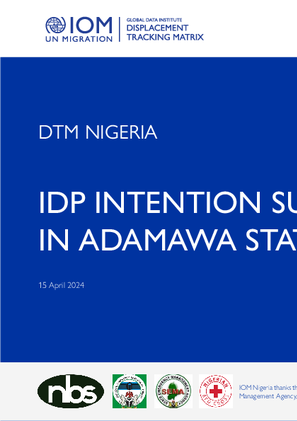
Contact
DTM Nigeria, iomnigeriadtm@iom.int
Language
English
Location
Nigeria
Period Covered
Nov 16 2023
Dec 18 2023
Activity
- Survey
- Displacement Solutions
- Return Intention
While many of the IDPs continued to be displaced for prolonged periods, there is a noticeable trend of increasing numbers of IDPs returning to their places of origin, as evidenced by Round 45 of DTM assessments (June 2023) identified 2,075,257 returnees in the region. Recognizing the growing number of returnees, the IOM Displacement Tracking Matrix (DTM), in collaboration with the Camp Coordination and Camp Management (CCCM) and Protection sectors, including the National Emergency Management Agency (NEMA), National Bureau of Statistics (NBS), State Emergency Management Agency (SEMA), Nigeria Red Cross Society (NRCS), and other key partners deemed it necessary to assess the future intentions (within the next 12 months) of individuals in displacement areas to provide appropriate solution interventions. The DTM of the IOM Nigeria Mission, with the support of the partners, led the Intention Survey (IS) in Adamawa State (including the other five states of the north-east) to assess IDPs who wish to return to their place of origin, locally integrate at their current location of displacement or relocate to another part of the state (LGA), within or outside the country.
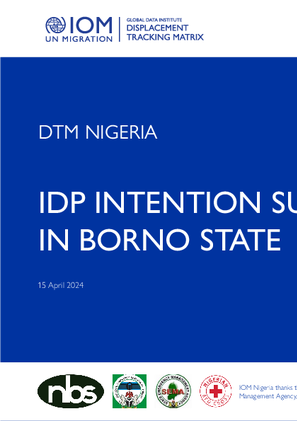
Contact
DTM Nigeria, iomnigeriadtm@iom.int
Language
English
Location
Nigeria
Period Covered
Nov 16 2023
Dec 18 2023
Activity
- Survey
- Return Intention
While many of the IDPs continued to be displaced for prolonged periods, there is a noticeable trend of increasing numbers of IDPs returning to their places of origin, as evidenced by Round 45 of DTM assessments (Sep 2023) identified 2,075,257 returnees in the region. Recognizing the growing number of returnees, the IOM Displacement Tracking Matrix (DTM), in collaboration with the Camp Coordination and Camp Management (CCCM) and Protection sectors, including the National Emergency Management Agency (NEMA), National Bureau of Statistics (NBS), State Emergency Management Agency (SEMA), the Nigerian Red Cross Society (NRCS), and other key partners deemed it necessary to assess the future intentions (within the next 12 months) of individuals in displacement areas to provide appropriate solution interventions. The DTM of the IOM Nigeria Mission, with the support of the partners, led the Intention Survey (IS) in Borno State (including the other five states of the north-east) through the BHA and ECHO fund. The aim of the IS was to assess IDPs who wish to return to their place of origin, locally integrate at their current location of displacement or relocate to another part of the state (LGA) or within the country.
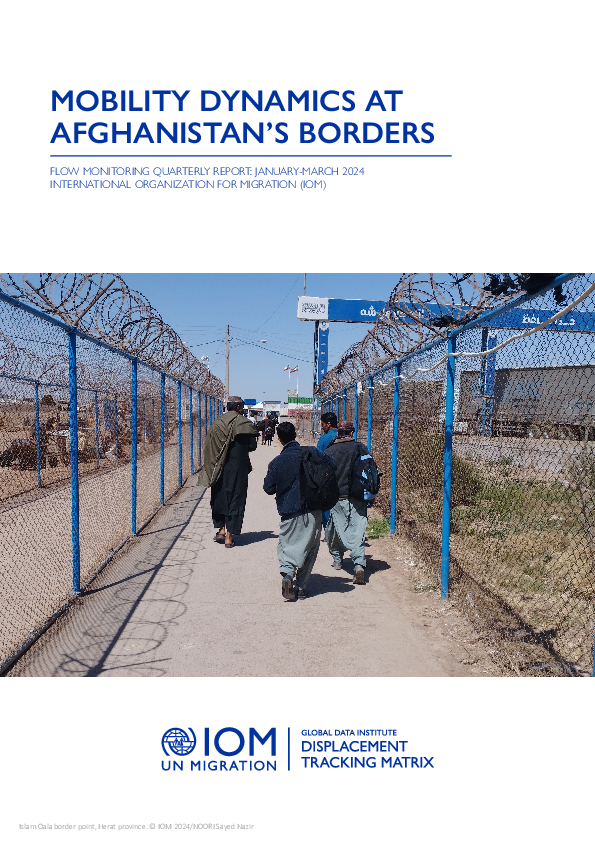
Contact
DTMAfghanistan@iom.int
Language
English
Location
Afghanistan
Period Covered
Jan 10 2024
Mar 31 2024
Activity
- Survey
- Flow Monitoring Survey
- Flow Monitoring
Over the course of decades marked by conflict, Afghanistan has experienced significant movement across its borders with neighboring countries the Islamic Republic of Iran and Pakistan. This movement, influenced by linguistic, geographical, and economic factors, has played a crucial role in shaping regional dynamics and fostering cultural ties between these countries. With 4.5 million Afghan nationals currently living in the Islamic Republic of Iran and 3.2 million currently living in Pakistan1, Afghan nationals not only seek economic opportunities, international protection and safety in these countries, but often visit family or participate in short-term travel for health and other reasons. In late 2023, policies and statements by officials in both the Islamic Republic of Iran and Pakistan called for the expulsion of undocumented foreigners, the majority of whom are Afghan nationals. Developments such as these recent policies targeting Afghan migrants have impacted movements to Afghanistan, as seen late last year when returns from Pakistan increased following the announcement of the “Illegal Foreigners’ Repatriation Plan (IFRP),” setting a deadline for unregistered or undocumented foreigners to voluntarily return to their countries or face deportation.
In response to these recent movements, IOM Afghanistan re-launched its DTM Flow Monitoring (FM) activity at the beginning of 2024 to provide critical insights into current mobility dynamics at Afghanistan’s borders. Flow Monitoring is designed to track the scale and characteristics of human mobility along the borders, including volume, intended destinations, reasons for movement, and intended lengths of stay. From January to the end of March 2024, DTM counted 567,411 individuals entering Afghanistan, 406,919 leaving Afghanistan, and interviewed 49,441 regarding their reasons for movement and intentions. The following report provides findings from DTM’s Flow Monitoring exercises for the first three months of data collection, examining trends and profiles among inflow and outflow groups to inform better targeted response mechanisms.
The report is structured in four sections. The first section, “Cumulative Flow Trends,” gives an overview of the total inflow and outflow numbers and trends between January and March. This section is linked to DTM’s Flow Monitoring Counting exercise (see details in “Methodology and Limitations”). The second and third sections, “Mobility Dynamics: The Islamic Republic of Iran” and “Mobility Dynamics: Pakistan” explore findings from interviews with people leaving and entering Afghanistan via borders with the Islamic Republic of Iran and with Pakistan, respectively. These sections are followed by “Mobility Dynamics: Conclusions” which summarizes and analyzes the findings from the interviews. These last three sections are linked to DTM’s Flow Monitoring Surveys exercise (see details in “Methodology and Limitations”).